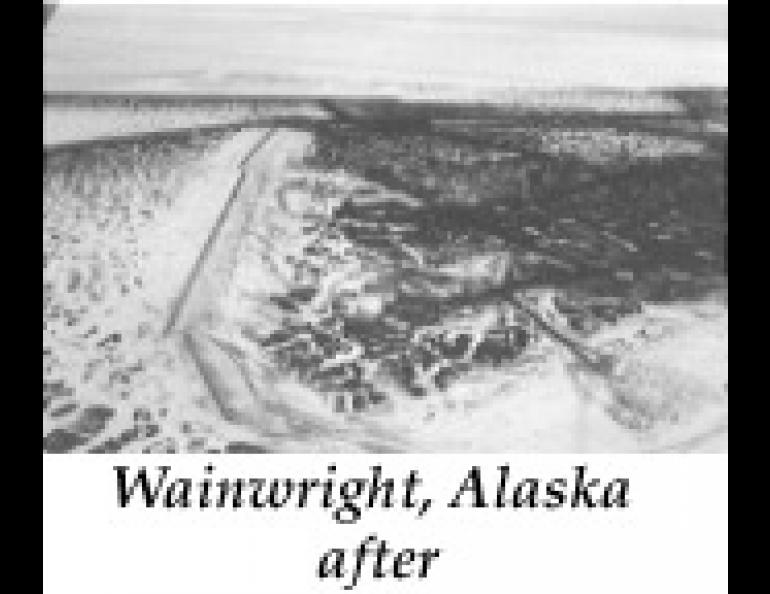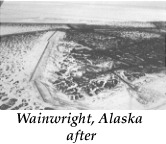

Snow that Won't Stay Still
The snow north of the Brooks Range isn't like the snow most people -- including most Alaskans -- are used to. It's long lasting (almost nine months), it's as dry and cutting as windblown sand, and it's either packed into a solid slab or moving with the winds.
The ceaseless motion of the snow -- eastward or westward along the coast, northward nearer the foothills -- makes it hard even to know how much of it there is. It blows over precipitation gauges without falling in to such an extent that we now think the true precipitation along the Arctic coast may be about three times the measured value; Barrow may be as wet as Fairbanks.
This shifty arctic snow can't be measured by sticking a ruler into the snow on the ground, because some areas have all the snow blown away except what is caught in the tundra vegetation, while others, such as river banks perpendicular to the wind, may have drifts big enough to bury fair-sized buildings. Over large parts of the North Slope away from the coast, no one has ever even tried to measure how much snow falls.
Although there is a great deal we still need to find out about Alaska's arctic snow, we do know enough to begin to manage its relentless movement. There are areas where it would be convenient if the snow piled up -- on the ice of reservoirs, for instance. And there are other areas -- in front of house doors or on roads -- where drifting can create massive problems. The magnitude of the drifting problem is suggested by the amount of snow which would pass through an imaginary gate, a meter wide and perhaps ten meters high, facing east near the coast -- a staggering 72 tonnes a year. (A tonne, or metric ton, is about 205 pounds heavier than a ton.)
A great deal of research has been carried out in Colorado and Wyoming on the management of drifting snow, and the Geophysical Institute has cooperated with the Rocky Mountain Forest and Range Experiment Station (RMFRES) of the U. S. Forest Service in designing snow control structures for the Arctic Slope. ARCO has built drift control fences at Prudhoe Bay, and water reservoirs at Barrow are filled partly by drifts trapped by snow fences. Another big success story is the protective snow fence at Wainwright.
When the North Slope Borough invited the Geophysical Institute and RMFRES to look at the snow drifting problems of the village of Wainwright near Barrow in 1975, snow drifts were everywhere. Many villagers had to dig tunnels to get in and out of their houses, and fires were almost impossible to fight. Geophysical Institute researchers have for many years measured the huge drifts on the Meade River, and we knew from these measurements about how much snow would have to be trapped to protect the village. Ron Tabler from RMFRES estimated that a 4-to-5 meter tall snow fence would be able to handle the necessary amount of snow. In 1982 the village corporation, Olgvoonik, Inc., completed building such a fence based on a design by CSM Inc. of Anchorage.
Although the fence has been highly effective in controlling drifting in the village, its full potential usefulness has not yet been tapped. Water in Wainwright is currently hauled by tank truck from lakes. The drift, however, contains about 100,000 tonnes of water a year -- more than 10,000 tank truck loads -- much of which currently drains through the village during the spring and early summer. That neighborhood pile of snow represents an impressive potential resource.
The snow isn't an easy resource even so. It would take additional planning and construction to channel the melt water from the drift into underground storage tanks and work out problems connected with permafrost. The village would have to limit current unrestricted use of the drift by snow machines and dogs, possibly by designating a specific part of the drift, which would not be used for water, as a recreation area.
The relentless winds of the north slope will continue to transport snow, but this can provide opportunities for cost-effective snow management. It costs far less to design things that will allow the wind to move snow from where it is a nuisance to where it is needed than to move snow with machinery.






